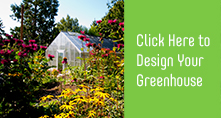How to Select a Greenhouse Kit
Selecting a Greenhouse
So, you've decided you want to buy a greenhouse. Congratulations! You're about to join a wonderfully enthusiastic group of greenhouse hobbyists who truly enjoy their greenhouse gardening. As you begin to investigate your purchase, you'll want to consider not only your present needs but your future needs as well. Careful planning will save lots of time and some additional expenses in the future.
A greenhouse can be a large investment so we recommend you gather lots of information about greenhouses and the additional equipment required to maintain a healthy growing environment. This will help you determine which greenhouse style and model and which related accessories will best suit your growing needs.
We're very pleased to share our expertise as you do your research. We suggest you read through the following helpful information as you evaluate your greenhouse needs and determine the best greenhouse style, site, covering material and supporting equipment.
Please don't be afraid to ask us questions. Your greenhouse purchase is important, and we want to ensure that you are completely comfortable with your purchase!
GREENHOUSE STYLES
Free-standing greenhouses are the most common category and include traditional peaked and curved-eave (or curved roof) free-standing greenhouses which are both still very popular in many gardens. Their square or rectangular shape provides maximum growing space, allowing room for benches on both sides and across the back.
Home-attached, or lean-to greenhouses, are designed to attach directly to your home, your garage or any existing external wall provided there is enough height to accommodate the peak of a lean-to greenhouse. Many people find lean-to greenhouses easily accessible and extremely convenient especially when installing the necessary power and water connections for the greenhouse operation.
GREENHOUSE CONSTRUCTION
It is our opinion, and this is an opinion shared throughout the industry, that aluminum frame greenhouses are best suited for a long term installation and are designed to accommodate a variety of glazing materials including glass and polycarbonate.
Aluminum frames are maintenance-free and will generally last a lifetime, making them ideally suited for greenhouse use. Wood frames are not maintenance-free and do not have as long a life span as aluminum frames.
Not all greenhouse frames are built the same so you'll want to be sure you select one that has been engineered to provide adequate structural strength. A quality greenhouse designed with the highest structural frame strength will include the following features.
- Withstand harsh weather conditions such as high winds and an accumulated snow or ice build up in the northern regions.
- Provide the required support for hanging baskets, grow lights, cooling and ventilation equipment and sidewall shelving.
- Include screened hinged storm doors which are a better design than sliding doors. Sliding doors are not as energy efficient as storm doors, and will result in greater heat loss. A screened door also allows extra ventilation when needed.
- An extensive selection of sizes and styles available. Costs or actual available space may dictate the size of a greenhouse.
- Flexibility regarding the potential to use a raised base support for the greenhouse resulting in the need for a "dropped" door. (Read on for more information regarding elevated height and "dropped" doors.)
Consider the desired overall height of your greenhouse. You can build the greenhouse up higher using a "kneewall" to achieve that additional height. However, if you choose to build on a "kneewall", you will need to "drop" the door down to avoid high steps in and out of the greenhouse.
Some companies may charge additionally for this service, but we are not one of them! We offer a free door drop with your greenhouse. Just let us know the measurement that you want!
GREENHOUSE COVERINGS
Glass
Truly a favorite, glass offers a high quality greenhouse covering. It is extremely attractive; allowing plants to be visible from outside, and glass also offers plenty of natural light, especially during winter months. Single and double tempered, unbreakable glass is available. Double glass greenhouses are designed for maximize heat efficiency.
Greenhouse Tip: If you purchase a single glass greenhouse, you can insulate the inside with a layer of plastic. This will help retain heat for the colder months the greenhouse is in use.
Polycarbonate
We offer polycarbonate greenhouse coverings in 6mm Twin Wall or 16mm 5 Wall. These panels have insulating features that can reduce your heating costs by 30% or more. The thicker the polycarbonate, the better it is at retaining heat. Light transmission is diffused through the polycarbonate and the light transmission can be about 10% less compared to glass.
As far as retaining heat, 16mm polycarbonate is best, followed by double glass, then 6mm polycarbonate, then single glass.
16mm 5 wall polycarbonate is the most energy efficient glazing material in today's greenhouse market. The light transmission is slightly lower at 62%. The benefit is an improved R value of 3.03 which is a 21% improvement over our previous 16mm thick triple wall polycarbonate. This means that a greenhouse glazed with our 5 wall polycarbonate will cost 21% less to heat than the previous triple wall polycarbonate glazing. In addition, the 5 wall polycarbonate is about 50% more efficient than insulated double glass, 10mm triple wall polycarbonate and 8mm 4 wall polycarbonate. It is approximately 80% more efficient than 6mm or 8mm twin wall polycarbonate. Arguably, this is the most energy efficient glazing material available in today's greenhouse market.
What's the R Value?
The R value is the unit used to measure the effectiveness of the thermal insulation offered by the greenhouse covering. Different thickness of glass and polycarbonate coverings will result in different R values. The higher the R value, the greater the heating and cooling efficiency.
Listed below are the R values for the various glass and polycarbonate coverings offered:
| 3mm Single Tempered Glass | R Value is 0.95 |
| Double Tempered Glass | R Value is 2.00 |
| 4mm Twin Wall Polycarbonate | R Value is 1.43 |
| 6mm Twin Wall Polycarbonate | R Value is 1.54 |
| 10mm Twin Wall Polycarbonate | R Value is 1.89 |
| 16mm Triple Wall Polycarbonate | R Value is 2.50 |
| 5 Wall Polycarbonate |
R Value is 3.03 |







